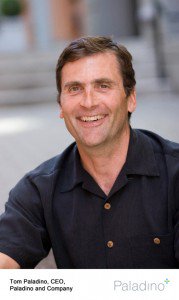By Suzann D. Silverman on April 12, 2013 in News
 The concept of sustainable design is taking significant steps forward, according to one expert, but it still has a way to go. While efforts are expanding into the planning stages and incorporating operations and asset management as well, hard data evidence of results are still missing, affirms Tom Paladino, founder of consulting firm Paladino and Co. Without that data, most developers are treating new-construction efforts on a one-off basis rather than taking a more programmatic approach to sustainable construction.
The concept of sustainable design is taking significant steps forward, according to one expert, but it still has a way to go. While efforts are expanding into the planning stages and incorporating operations and asset management as well, hard data evidence of results are still missing, affirms Tom Paladino, founder of consulting firm Paladino and Co. Without that data, most developers are treating new-construction efforts on a one-off basis rather than taking a more programmatic approach to sustainable construction.
Certification programs are both proliferating and expanding, offering more options to put an official seal of approval on local materials, efficiency measures and other improvements. And research is picking up, too, for instance through the Greenprint Foundation, which is collecting data from a growing number of companies to track carbon emissions, with some very lofty goals for the industry at large. But those efforts are focused on cleaning up the environment, Paladino notes, who was instrumental in developing the U.S. Green Building Council’s Leadership in Energy and Environmental Design certification program, directed its pilot program and has been technical editor and author of the version 4 reference guides.
While environmental improvements are certainly a worthwhile pursuit, nobody is really studying property performance to determine the best business results. For instance, while the industry can measure a leasable area, opinions differ on specifics that combine to create a daylit building that contributes to productivity gain—let alone can they precisely measure what that productivity gain is. The result is that only a few developers are approaching application of sustainable design in multiple projects systematically, with business performance goals in mind.
Expansion of the sustainability team might help further those tracking efforts. While there are 200,000 LEED APs out in the market now, there are few other types of sustainability experts in most real estate companies, Paladino maintains, making their more environmental performance-focused expertise the main driver of company strategy. Some companies have been appointing a C-suite executive to oversee sustainability efforts, but that person tends to be as focused on the business side as the LEED experts are on sustainability. Rare is there a person in place that can join the two together.
As expertise is further developed, these professionals in the development firms will also have to learn how to work more closely with similar experts in other companies contributing to the development process—the architects, the facilities and property management firms, the construction firms. That will help create a more cohesive, precise and measurable process that can be standardized for portfolio-wide or even cross-company strategy.
All this gives development firms plenty to work on, but Paladino notes additional challenges ahead. Even as they learn what strategies best contribute to business performance, the model is changing as tenant needs evolve. For instance, whereas traditionally a landlord would plan to move a growing tenant to a new, larger suite as their space needs change, in the future a better approach might instead be a less square-footage-oriented solution such as finding find ways to add workstations within common areas or improving their technology so employees can work externally, at the same time providing enticements for them to return to the office for collaboration.
Suzann D. Silverman is editorial director of Commercial Property Executive. A full discussion with Tom Paladino appeared in the April 2013 issue of CPE.


